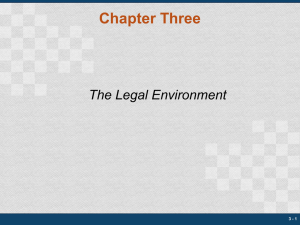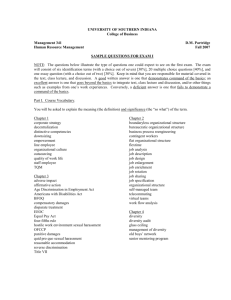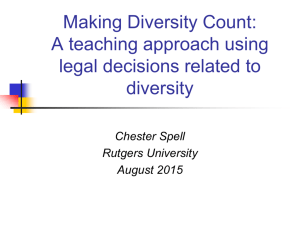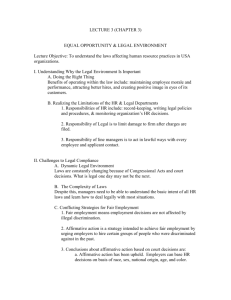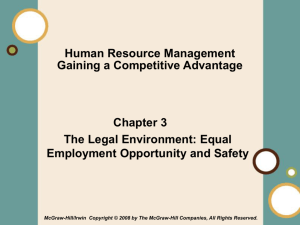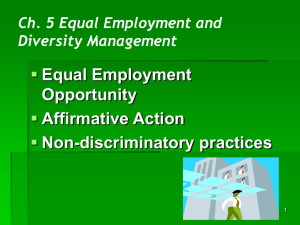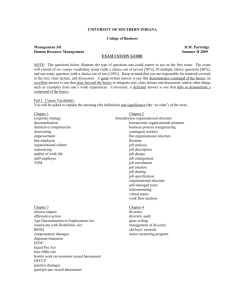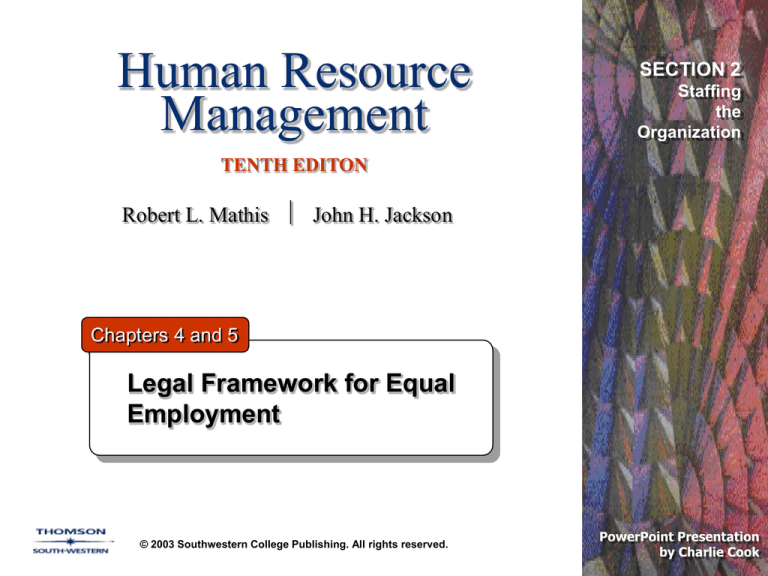
Human Resource
Management
SECTION 2
Staffing
the
Organization
TENTH EDITON
Robert L. Mathis John H. Jackson
Chapters 4 and 5
Legal Framework for Equal
Employment
© 2003 Southwestern College Publishing. All rights reserved.
PowerPoint Presentation
by Charlie Cook
Learning Objectives
Be able to define the following: diversity, EEO, protected class, affirmative action,
and reverse discrimination (pages 101-104).
List and describe (date and key provision) the following acts: Civil Rights Act of
1964, Title VII, Executive Order 11246 (1965), Civil Rights Act of 1991, Equal Pay
Act (1963), Age Discrimination (1990), ADA Act (1990), and FMLA of 1990. See
Appendix C.
*Define disparate treatment and disparate impact. Describe the types of evidence
for a disparate treatment and disparate impact case used in deciding when
discrimination has occurred; be able to list the four requirements for disparate
treatment (44-45). Be able to list and describe the following company defenses
against a prima facie case of discrimination for disparate impact: job relatedness,
BFOQ, BFSS, and business necessity
List key factors in determining which organizations fall under Title VII.
Be able to use flow statistics (e.g., 4/5th rule) and explain the results
Define affirmative action plan and describe the Supreme Court’s requirement for a
voluntary affirmative action plan
Define Sexual Harassment
© 2002 Southwestern College Publishing. All rights reserved.
4–2
Learning Objectives (cont’d)
*For ADA, describe who is protected (i.e., disabled individuals) and define
disabled person; also, explain reasonable accommodation and undue hardship
Identify typical EEO record-keeping requirements and those records used in the
EEO investigative process. In particular, while all employers should keep
employment demographic data, the EEOC can request employment data from
organizations with ____ employees and private employers with ___ or more
employees must file thee EEO-1 form annually.
Chapter 5
*Be able to define the glass ceiling, and explain gender discrimination
using glass ceiling, glass door, and glass elevator concepts and how
women can break the glass (or move beyond it).
Define the two types of sexual harassment: quid pro quo and hostile
environment
Explain what the courts have said about sexual harassment and how an
affirmative defense can protect or limit the organization’s liability.
© 2002 Southwestern College Publishing. All rights reserved.
4–3
Diversity, Equal Employment,
and Affirmative Action
Diversity
– The variety of dimensions differentiating people
Equal Employment Opportunity
– Individuals should have equal treatment in all
employment-related actions.
Protected Class
– Individuals within a group identified for protection
under equal employment laws and regulation.
• Race, ethnic origin, color • Gender • Age
• Disability
• Military experience
• Religion
• Marital status
• Sexual orientation
© 2002 Southwestern College Publishing. All rights reserved.
4–4
Major Equal Employment Laws and Concepts
Civil Rights Act of 1964, Title VII
– Coverage
•
•
•
•
•
•
All private employers with 15 or more employees
All educational institutions
State and local governments
Public and private employment agencies
Labor unions with 15 or more employees
Joint labor/management apprenticeship committee
– Established the Equal Opportunity Commission to
enforce the act’s provisions.
© 2002 Southwestern College Publishing. All rights reserved.
4–6
Affirmative Action Regulations
Executive Orders 11246,11375, and 11478
– Requires holders of federal contracts not to
discriminate on the basis of race, color, religion,
national origin, or sex and to develop affirmative
action plans.
– Office of Federal Contract Compliance (OFCCP) in
the Department of Labor enforces these
presidential orders.
© 2002 Southwestern College Publishing. All rights reserved.
4–7
Enforcement Agencies
Equal Employment Opportunity Commission
– EEOC is the enforcement authority for EEO laws.
– Composed of five members appointed by the
President and confirmed by the Senate.
– Members (limited to no more than three from the
same political party) serve seven year terms.
Office of Federal Contract Compliance
– OFFCP ensures that federal contractors have
nondiscriminatory practices and take affirmative
action to overcome the effects of past
discrimination.
© 2002 Southwestern College Publishing. All rights reserved.
4–8
Elements of EEO Compliance
EEO Policy
Statement
Pre-employment vs.
After-Hire Inquires
EEO
Records
EEO
Compliance
EEOC Compliance
Investigation Process
Employer Responses
to EEO Complaints
© 2002 Southwestern College Publishing. All rights reserved.
4–9
Civil Rights Act of 1991
Significant provisions:
– Employment practices must be job-related and
consistent with business necessity.
– Plaintiffs must identify particular employment practice
and show that protected-class status was a factor in the
employment practice.
– Provided limited compensatory damages for intentional
discrimination.
– Allows plaintiffs to seek jury trials.
– Prohibited norming and use of alternative scoring based
on protected class membership.
– Extended EEO coverage to U.S. citizens overseas.
© 2002 Southwestern College Publishing. All rights reserved.
4–15
Affirmative Action
Affirmative Action
– A process in which employers identify problem areas, set
goals, and take positive steps to enhance opportunities for
protected-class members and to remove the effect of past
discrimination.
Affirmative Action Plan (AAP)
– Formal document that an employer compiles annually for
submission to enforcement agencies.
Voluntary AAP
– Supreme Court says it must be temporary, have no permanent
adverse impact on White workers, and be designed to correct
a demonstrable imbalance between minority and nonminority
workers.
Reverse Discrimination
– Occurs when a person is denied an opportunity because of
preferences give to protected-class individuals who may be
less qualified.
© 2002 Southwestern College Publishing. All rights reserved.
4–16
Components of an Affirmative Action Plan (AAP)
Figure 4–3
© 2002 Southwestern College Publishing. All rights reserved.
4–17
Prima Facie Case of Discrimination
Disparate Treatment
– A situation that exists when protected-class members are
treated differently from others.
• Burden of proof falls on plaintiff: member of protected class,
applied for a job which he/she was qualified, he/she was
rejected, and employer continued to seek applicants for the
job
Disparate Impact
– Occurs when substantial underrepresentation of protectedclass members results from employment decisions that work
to their disadvantage.
– Griggs vs. Duke Power (1971) decision:
• Lack of intent to discriminate is no defense if discrimination
occurs.
• The employer has the burden of proof in proving that an
employment requirement is a “business necessity.”
– Retaliation
• EEO laws prohibit employers from taking punitive actions
against
individuals
who exercise their legal rights.
© 2002 Southwestern
College Publishing.
All rights reserved.
4–18
Company Defense
Business Necessity
– A practice that is necessary for safe and efficient
organizational operations.
Bona Fide Occupational Qualifications (BFOQ)
– A business characteristic providing a legitimate
reason why an employer can exclude persons on
otherwise illegal bases of consideration.
Job Relatedness
Bona Fide Seniority System
© 2002 Southwestern College Publishing. All rights reserved.
4–20
Uniform Guidelines on
Employee Selection Procedures
“No Disparate Impact”
– Disparate impact occurs whenever a substantial
underrepresentation of protected-class members is
evident in selection decisions.
4/5ths Rule
– If the selection rate for a protected-class is less
than 80% (4/5ths) of the selection rate for the
majority group or less than 80% of the group’s
representation in the relevant labor market, then
discrimination exists.
© 2002 Southwestern College Publishing. All rights reserved.
4–21
External Disparate Impact
Source:
© 2002 Southwestern College Publishing. All rights reserved.
Figure 4–7
4–22
Disparate Impact
Demographic Information
Total
Total
applicants hired
260
125
Total
Total
Majority Majority
Number of
Total Number Number of
Total
Minority Minorities applicants hired
women
of employees women in Number of
applicants
hired
employees with
with org.
labor force individuals
org. having
having
with
in labor
specified skill specified skill specified force with
set
set
skill set
specified
skill set
100
40
160
85
10
250
6,000, 12,000,
000
000
Figure 4–6
© 2002 Southwestern College Publishing. All rights reserved.
4–23
Laws on Sex/Gender Discrimination
Acts
Pregnancy
Discrimination Act
(PDA) of 1978
Requires an employer to treat maternity leave the
same as other personal or medical leaves.
Employers must treat pregnant employees the
same as other employees.
Family Medical
Leave Act (FMLA)
of 1990
Requires that individuals be allowed up to 12
weeks of unpaid leave for family/medical purposes.
Equal Pay Act of
1963
Requires employers to pay similar wage rates for
similar work without regard to gender. Exceptions
are permitted for differences in seniority,
performance, output, and other work-related
factors.
© 2002 Southwestern College Publishing. All rights reserved.
4–24
Sex/Gender Discrimination
Pay Equity (Comparable Worth)
– The concept that pay for jobs requiring comparable
levels of knowledge, skill, and ability should be paid
similarity, even if actual duties differ significantly.
– Arises from the continuing gap between the
earnings of women and men.
– Courts have consistently ruled against the concept.
Sexual Harassment
– Actions that are sexually directed, are unwanted,
and subject the worker to adverse employment
conditions or create a hostile work environment.
© 2002 Southwestern College Publishing. All rights reserved.
4–25
Sexual Harassment and
Workplace Relationships
Types of sexual harassment
– Quid pro quo
• Linking employment outcomes to the harassed
individual’s granting of sexual favors.
– Hostile environment
• Allowing intimidating or offensive working conditions
to unreasonably affect an individual’s performance or
psychological well-being.
© 2002 Southwestern College Publishing. All rights reserved.
4–26
Sexual
Harassment
Liability
Determination
Source: Virginia Collins and Dr. Robert L.
Mathis, Omaha, Nebraska. May not be
reproduced without permission
© 2002 Southwestern College Publishing. All rights reserved.
Figure 5–8
4–27
Sexual Harassment and
Workplace Relationships (cont’d)
Legal Standards on Sexual Harassment
– Tangible employment actions (e.g., termination)
that result from sexual harassment create a liability
for the employer.
– Affirmative defense for employers in dealing with
sexual harassment incidents includes:
•
•
•
•
Establishing a sexual harassment policy
Communicating the policy regularly
Training employees to avoid sexual harassment
Investigating and taking actions when complaints arise
© 2002 Southwestern College Publishing. All rights reserved.
4–28
Sex Discrimination in Jobs and Careers
The “Glass Ceiling”
– Discriminatory practices that have prevented women and
other protected-class members from advancing to executivelevel jobs.
“Glass Walls” and “Glass Elevator”
– The tendency for women to advance only in a limited number
of functional fields within an organization.
Breaking the Glass
–
–
–
–
–
Establishing mentoring programs
Providing career rotation
Increasing top management and boardroom diversity
Establishing goals for diversity
Allowing for alternative work arrangements
© 2002 Southwestern College Publishing. All rights reserved.
4–29
Americans with Disabilities Act (ADA)
ADA Concepts
Disabled Person
Someone who has a physical or mental impairment
that substantially limits life activities, who has a
record of such impairment, or who is regarded as
having such and impairment.
Essential Job
Functions
Fundamental job duties of the employment position
that an individual with a disability holds or desires.
Reasonable
Accommodation
A modification or adjustment to a job or work
environment that enables a qualified individual with
a disability to have an equal employment
opportunity.
Undue Hardship
Significant difficulty or expense imposed on an
employer in making an accommodation for
individuals with disabilities.
© 2002 Southwestern College Publishing. All rights reserved.
4–30
Major Sections of the Americans with Disabilities Act
Figure 4–4
© 2002 Southwestern College Publishing. All rights reserved.
4–31
Other Employment Discrimination Acts
Act
Age Discrimination
in Employment
(ADEA)
Prohibits employment discrimination against all
individuals age 40 or older working for employers
having 20 or more workers. Does not apply if age
is a job-related qualification (BFOQ).
Immigration Reform
and Control Act
(IRCA)
Prohibits employment discrimination against
persons legally permitted to work in the United
States. Requires employers to document
eligibility for employment. Provides penalties for
knowingly employing illegal workers.
© 2002 Southwestern College Publishing. All rights reserved.
4–32
Other Types of Discrimination
Type of Discrimination
Religious Discrimination
Discrimination is illegal unless religion is a
bona fide occupational qualification.
Reasonable accommodation is required.
Genetic Bias
Discrimination
Developing area with no clear guidelines
as yet on use of genetic information in
employment.
Appearance and Weight
Discrimination
Application of workplace dress codes is
permitted. Height and weight-related job
requirements must be job-related.
Sexual Orientation
At present, federal protection against
workplace discrimination has not been
granted.
© 2002 Southwestern College Publishing. All rights reserved.
4–33
Other Types of Discrimination
Type of Discrimination
Veterans’
Employment Rights
The Vietnam-Era Veterans Readjustment Act and
the Uniformed Services Employment and
Reemployment Act encourage the employment of
veterans and require employers to provide leaves
of absence and reemployment rights for
employees called to active duty.
Seniority and
Discrimination
Courts have held that the application of a valid
seniority system does not violate the rights of
protected-class individuals.
Conviction and
Arrest Records
Employers may not use arrest records in
employment decisions. Conviction records may
be used in determining employability if the
offense is job-related.
© 2002 Southwestern College Publishing. All rights reserved.
4–34
Equal Employment Charges by Type
Figure 4–5
© 2002 Southwestern College Publishing. All rights reserved.
4–35

